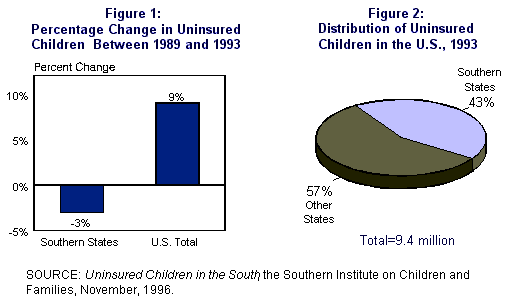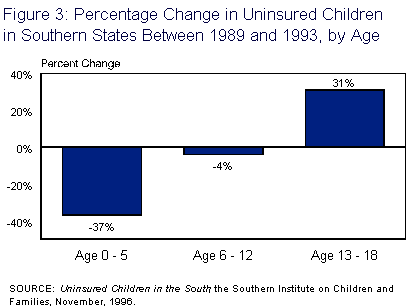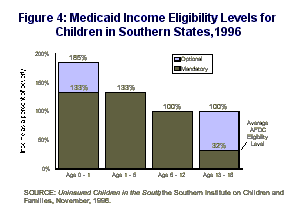Uninsured Children in the South
Over 4 million children living in the South have no health insurance coverage. While the South experienced a decrease (3 percent) in the number of uninsured children from 1989 to 1993 — the number of uninsured children nationally increased by 9 percent (Figure 1) — the region accounts for a dispro-portionately high share of uninsured children in America. Over a third (36 percent) of American children live in the South, but the region accounted for 43 percent of America’s uninsured children (Figure 2).

Uninsured rate varies across States
Overall, 15 percent of children in the South are uninsured, but southern states vary widely in the proportion of their children without health insurance coverage.
- The uninsured rate in the South ranges from 10 percent in North Carolina and Missouri to 25 percent in Louisiana.
- At least one in five children in Louisiana, Oklahoma and Arkansas are uninsured.
- Nineteen percent of the children in Texas, the largest state in the region, were without insurance. These 1 million uninsured Texan children accounted for one-fourth of all uninsured children in the South.
Older children most at risk
Of the 4 million uninsured, 43 percent were between the ages of 13 and 18 years; school age children 6 through 12 accounted for 37 percent; and preschool children under age 6 accounted for 20 percent. In 1993, 1.8 million southern teenagers had no insurance, of whom one third were poor.

The number of uninsured children under age 6 — the focus of initial Medicaid expansion efforts — decreased by 37 percent in the South between 1989 and 1993 (Figure 3). In contrast, the number of uninsured teenagers increased 31 percent.
Medicaid’s Role
Medicaid is the federal-state health program for the poor. Reductions in the number of uninsured children in the South are largely attributable to changes in federal Medicaid laws that required states to expand income eligibility levels for children and to gradually increase the minimum eligibility age. Recent federal legislation required states to provide Medicaid coverage to children:

- under 1 yearwith family incomes up to 133 percent of poverty; states have the option to expand coverage to 185 percent and all southern states except Alabama, Arkansas, Louisiana and Virginia have gone beyond the federal minimum eligibility levels (Figure 4);
- up to age 6with family incomes up to 133 percent of poverty; and
- over age 6who are poor ($12,980 for a family of three in 1996). Poor children ages six to 12 are currently covered; states have the option to cover poor children up to age 18 and will be required to cover all poor children by the year 2002. Currently, seven southern states have extended coverage to these children. The remaining 10 states use AFDC eligibility levels, which average 32 percent of poverty, but range from 15 percent in Alabama to 54 percent in Tennessee.
Issues
These findings demonstrate the important role that Medicaid plays in covering children. However, Medicaid’s potential for covering uninsured children in the South is not fully realized, evidenced by the fact that 28 percent of uninsured children are poor. This is in part due to the fact that eligibility levels for teenagers (the ages where federal requirements for coverage of the poor have yet to be phased-in) still vary widely by state. For example, Texas covers only teens living in families who meet its state established AFDC eligibility levels — income below 17 percent of the federal poverty level.
In addition, not all children who are eligible for Medicaid participate in the program. Lack of information about the availability of Medicaid coverage, as well as eligibility barriers affect the ability of many needy families to gain Medicaid coverage for their children. In addition, recent changes in welfare policy and coverage of disabled children have the potential to reduce the number of children covered by Medicaid and to make information about the availability of Medicaid program more difficult to obtain.
Data presented in this factsheet are based on Uninsured Children in the South, prepared by the Southern Institute on Children and Families, November 1996. That study analyzed the 1994 Current Population Survey (CPS) data for 17 southern states and the District of Columbia. Because of recent revisions to the CPS questionnaire, 1994 — which provided 1993 data — is the latest that can be reliably compared to earlier years. Data are included for the District of Columbia and the following states: Alabama, Arkansas, Delaware, Florida, Georgia, Kentucky, Louisiana, Maryland, Mississippi, Missouri, North Carolina, Oklahoma, South Carolina, Tennessee, Texas, Virginia and West Virginia.
The Henry J. Kaiser Family Foundation is an independent national health care philanthropy and is not associated with Kaiser Permanente or Kaiser Industries. Established in 1948 by industrialist Henry J. Kaiser, the Foundation focuses its work on four main areas: health policy, reproductive health, HIV, and health and development in South Africa.
Uninsured Children in the South:
Press Release Fact Sheet


